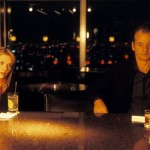Jonathon Rosenbaum on Lost in Translation:
Coppola does a fair job of capturing the fish-tank ambience of nocturnal, upscale Tokyo and showing how it feels to be a stranger in that world, and an excellent job of getting the most from her lead actors. Unfortunately, I’m not sure she accomplishes anything else.
I like that Rosenbaum threw “not sure” into that last sentence, as if he’s still mulling over his reaction. I feel the same way. It’s that rarest of finds: an American film that is invested enough in its characters to reveal them slowly, patiently to the audience. For instance, in the third act of the film, when most writer/directors would send their leads into an impassioned and cliche-ridden argument, Coppola sits Bill Murray and Scarlett Johansson on opposite sides of a table and films them from a distance. It’s an awkward moment — uncomfortable and tense and recognizably real. I loved it. Their final embrace is also brilliantly staged.
But, as I watched Lost in Translation, I kept thinking of two other films, and it suffered for the (admittedly unfair) comparison. Hou Hsiao-Hsien’s Good Men, Good Women also depicts the modern Asian metropolis as a storehouse of stuff — of manufactured goods marketed, packaged, and photographed with the glossy hipness of a five-page spread in Architectural Digest — but Hou’s film grounds that critique in a particular cultural and historic context. Like a few others, I was annoyed by the outsider-looking-in-and-laughing easy jokes that give Lost in Translation‘s American audiences something to mock but too little to admire. Charlotte’s solitary walks through a temple and a flower-arranging class do offer something of a counter-balance. I guess I’m just ultra-sensitive to anything that smacks of American xenophobia these days.
More often, though, I was thinking of Tsai Ming-Liang, and of his film, The Hole, in particular. Like Lost in Translation, The Hole is about the desperate desire for communion in an alienating environment, told as an unlikely “love” story. Tsai and Coppola share an interest in elliptical editing, but their styles are quite different. Lost in Translation is composed of brief episodes — short takes of beautifully composed images — while Tsai tends to leave his camera running for minutes at a time. What can I say? I prefer the latter, and at times I sensed that Coppola does to. We often see Charlotte and Bob alone in their rooms, bored and lonely, but we aren’t forced to experience it with them. The most impressive shots, I thought, were of Charlotte pressed against her hotel window, looking over the Tokyo sprawl. It’s a familiar image to Tsai’s fans (is Coppola one?). At times, I wish we could have stayed there longer with her and come to know her better.
Think I’m going to have to pick up the soundtrack next time I’m out. Great stuff from Air, Kevin Shields, My Bloody Valentine, and The Jesus & Mary Chain.
